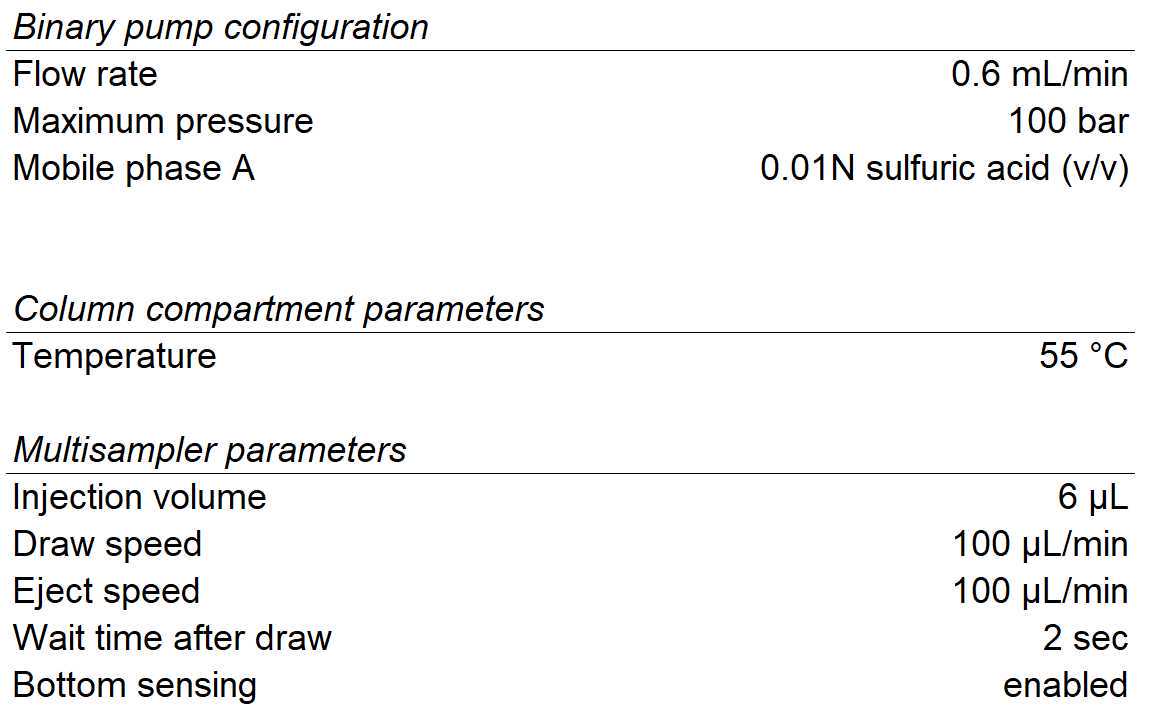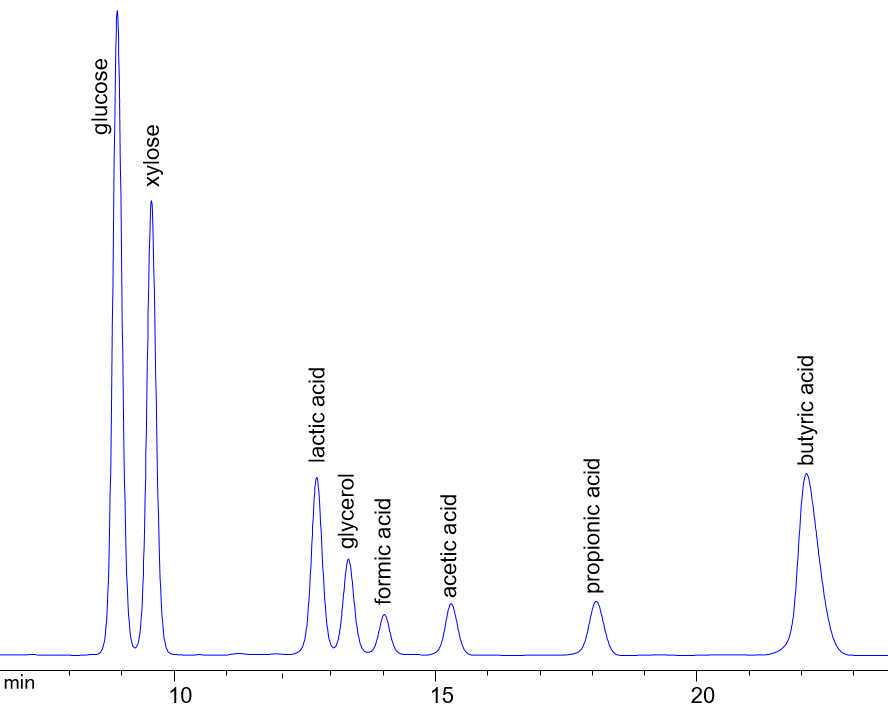Analysis of sugars, small organic acids, and alcohols by HPLC-RID
Gregg T. Beckham, Hannah M. Alt, Kelsey J. Ramirez, Stefan J. Haugen, Sean P. Woodworth, William E. Michener, Morgan A. Ingraham, Alexander F. Benson
formic acid
acetic acid
propionic acid
butyric acid
lactic acid
glucose
xylose
arabinose
glycerol
carboxylic acids
87H
HPLC
refractive index detector
RID
monomeric sugars
Disclaimer
This protocol is for research purposes only.
Abstract
An analytical method was developed using high performance liquid chromatography with refractive index detection (HPLC-RID) to quantify the concentration of sugars and carboxylic acids including formic acid, acetic acid, propionic acid, butyric acid, lactic acid, glucose, xylose, arabinose, and glycerol in aqueous samples. This list is non-exhaustive as this isocratic method with an acid modified mobile phase is compatible with analysis of many alcohols, small acids, and sugars. This method utilizes a Bio-Rad Aminex HPX-87H Ion Exclusion Column to provide chromatographic separation.
Before start
All solvents and chemicals used are listed in the ‘Materials’ section. These are excluded from in-line references to maintain clarity and keep the steps concise.
Steps
Preparation of mobile phase and instrument equilibration
Mobile phases
- To make 0.01 N sulfuric acid (0.005 M), dilute 1.0 mL of 10 N sulfuric acid into 1.0 L of 18.2MΩ⋅cm ultrapure water (UPW). Volumetric preparation of this mobile phase will yield the most reproducible chromatography. See note below.
Instrument equilibration
- Purge instrument with 0.01 N sulfuric acid solution made in the previous step. Be certain the instrument is purged through the entire flow path including the detector, before the analytical column is plumbed in. The Aminex 87H column is sensitive to solvents, for example, a higher amount of methanol will damage the column. The purge step is needed to remove all solvents/mobile phases from the analytical system. (See Bio-Rad's 'Instruction Manual' for Aminex resin-based columns for solvent compatibility and installation details).
- Add the guard column and analytical column to the system and begin equilibrating the column at a low flow rate of 0.2 mL/min while the column reaches analysis temperature.
- During the column equilibration, begin purging the reference cell of the refractive index detector (RID), this process will continue through the final equilibration of the column.
- At intervals of at least 10 minutes, increase the flow by 0.2 mL/min until you reach the method flow of 0.6 mL/min.
- Once the column is up to method flow and both the column compartment and the RID are at method temperature and stable, the RID reference cell can be closed. This typically takes around 30 minutes after method flow is reached. A longer purge of the reference cell is not detrimental.
- After the reference cell is closed, wait for the RID signal to stabilize before starting analysis.
Preparation of standards
Standards
- Allow standard level ampules (listed in 'Materials' section) to come to room temperature, vortex, and transfer contents of ampules into 2 mL amber HPLC vials.
- To create lower concentration calibration levels than provided in the kit, dilute the lowest concentration ampule to your desired concentration. <img src="https://static.yanyin.tech/literature_test/protocol_io_true/protocols.io.5qpvob7y9l4o/psvvbjm372.jpg" alt="Example calibration concentration table created from commercial standards 'Carboxylic Acids Standards Kit' by Absolute Standards referenced in 'Materials'. Notice the calibration range was extended to lower concentrations by diluting "level 1" by 2x, 5x, and 10x, respectively. Calibration verification standard (CVS) level is a commercial quality control level described in section 6.2. (Click to enlarge)" loading="lazy" title="Example calibration concentration table created from commercial standards 'Carboxylic Acids Standards Kit' by Absolute Standards referenced in 'Materials'. Notice the calibration range was extended to lower concentrations by diluting "level 1" by 2x, 5x, and 10x, respectively. Calibration verification standard (CVS) level is a commercial quality control level described in section 6.2. (Click to enlarge)"/>
Preparation of samples
Samples
- Samples must be filtered through a 0.2 µm or smaller filter prior to injection on the HPLC ('Materials' section includes part numbers for filters to use depending on matrix composition)
- Samples expected to be over the linear range of the instrument should be diluted to ensure accurate analysis and avoid carryover.
HPLC-RID analysis
Method Specifications
Analysis is performed using an Agilent 1200 Series High Performance Liquid Chromatography (HPLC) system. An isocratic concentration of 0.01N sulfuric acid through an Aminex HPX-87H column (300 x 8.7 mm, 9 μm particle size) is used to achieve separation at a flow rate of 0.6 mL/min. Quantitation is determined using refractive index detection (RID). Column and RID are both held constant at 55 °C and each sample and standard is injected at a volume of 6.0 μL.

Retention time of analytes is dependent on the configuration of the HPLC and will vary from instrument to instrument. Retention time markers for each analyte should be run individually to assess the total required run time of the analysis based on elution. Additional analytes not listed in this protocol may be compatible with these instrument parameters. This re-emphasizes the need to run single analyte retention time markers to prevent co-eluting peaks. For the analyte list provided here, the method run time is 27 minutes.
Analytical Quality Control
Multiple strategies are utilized when performing this analysis to ensure instrument stability and reproducibility.
Calibration Curves
All compounds must have a correlation coefficient (r2) of 0.995 or greater using a linear calibration fit and ignore the origin.
Calibration Verification Standards (CVS)
A calibration verification standard (CVS) is a level provided by the manufacturer that is re-analyzed every 20 or fewer samples to ensure instrument drift remains within the determined acceptance criteria. Acceptable CVS recoveries for this analysis are within 10% of the expected amount. Acceptance criteria may differ between instruments and should be determined experimentally.
Example Chromatography



